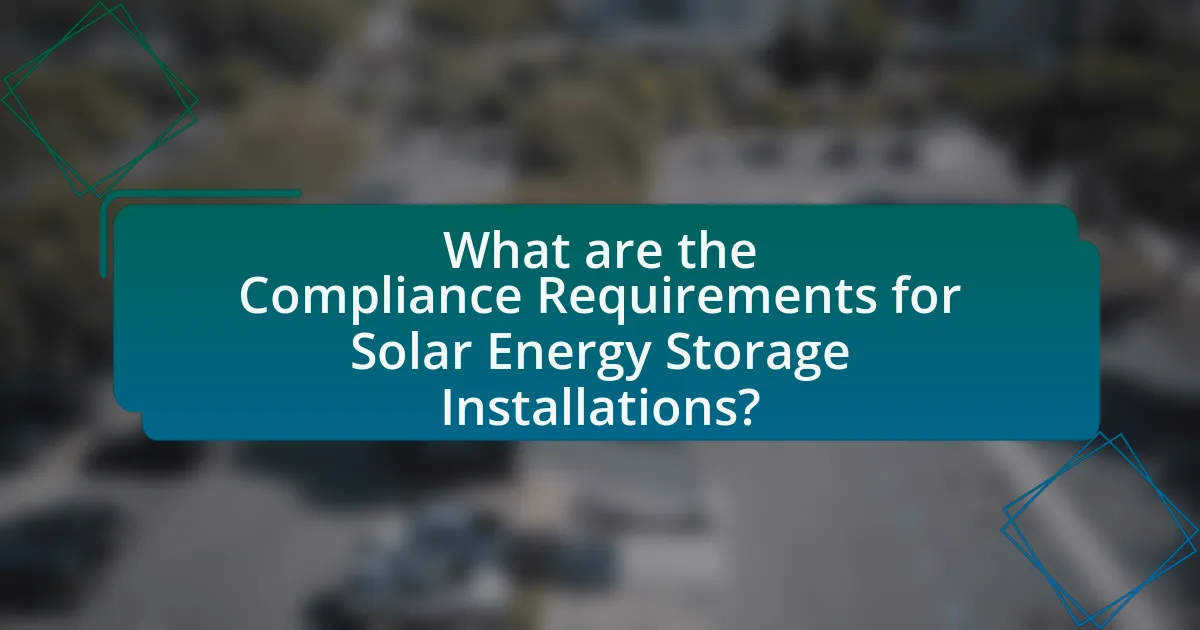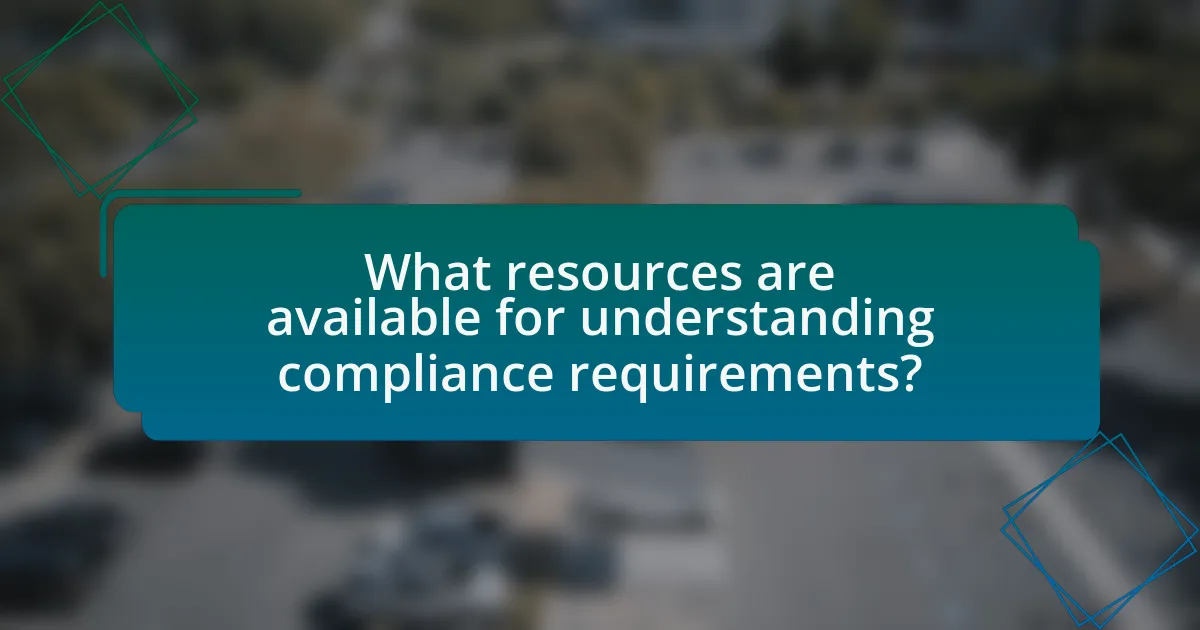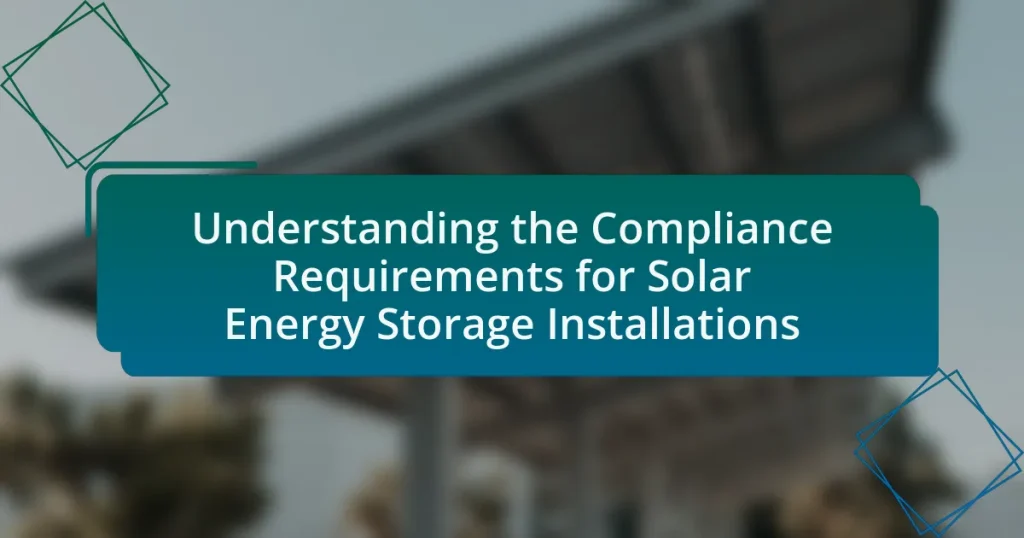The article focuses on the compliance requirements for solar energy storage installations, emphasizing the importance of adhering to local, state, and federal regulations, as well as safety standards set by organizations like the National Fire Protection Association (NFPA) and Underwriters Laboratories (UL). It outlines the critical role of compliance in ensuring safety, reliability, and efficiency, while also detailing the risks associated with non-compliance, such as legal penalties and safety hazards. Additionally, the article discusses the various regulatory bodies involved, key compliance standards, and best practices for maintaining compliance throughout the installation and operational phases of solar energy storage systems.
What are the Compliance Requirements for Solar Energy Storage Installations?


The compliance requirements for solar energy storage installations primarily include adherence to local, state, and federal regulations, as well as safety standards set by organizations such as the National Fire Protection Association (NFPA) and Underwriters Laboratories (UL). These regulations often mandate proper permitting, installation practices, and inspections to ensure safety and reliability. For instance, the National Electrical Code (NEC) outlines specific guidelines for the installation of energy storage systems, including battery storage, to mitigate risks such as electrical hazards and fire. Compliance with these standards is essential for the legal operation of solar energy storage systems and to qualify for incentives or rebates.
Why is compliance important for solar energy storage systems?
Compliance is important for solar energy storage systems because it ensures safety, reliability, and efficiency in their operation. Adhering to regulations and standards minimizes risks such as electrical hazards, fire, and equipment failure, which can arise from improper installation or operation. For instance, compliance with the National Electrical Code (NEC) and Underwriters Laboratories (UL) standards helps guarantee that systems are designed and installed correctly, reducing the likelihood of accidents. Furthermore, compliance can enhance the longevity of the equipment and optimize performance, ultimately leading to better energy management and cost savings for users.
What risks are associated with non-compliance?
Non-compliance with regulations in solar energy storage installations poses significant risks, including legal penalties, financial losses, and safety hazards. Legal penalties can involve fines or sanctions imposed by regulatory bodies for failing to adhere to established guidelines. Financial losses may arise from the inability to access incentives or rebates, as well as potential costs associated with rectifying non-compliant installations. Safety hazards can lead to accidents or failures in the system, endangering both property and individuals. For instance, the National Fire Protection Association (NFPA) has established codes that, if not followed, can result in dangerous situations, highlighting the critical importance of compliance in ensuring safety and operational integrity.
How does compliance enhance safety and reliability?
Compliance enhances safety and reliability by ensuring that solar energy storage installations adhere to established standards and regulations. These standards, such as those set by the National Fire Protection Association (NFPA) and Underwriters Laboratories (UL), provide guidelines for safe installation, operation, and maintenance practices. Adhering to these guidelines minimizes risks such as electrical hazards, fire incidents, and equipment failures, thereby protecting both users and the environment. For instance, a study by the U.S. Department of Energy highlights that compliance with safety standards can reduce the likelihood of accidents by up to 50%, demonstrating the critical role of compliance in enhancing overall safety and reliability in solar energy systems.
What regulatory bodies govern solar energy storage compliance?
The regulatory bodies that govern solar energy storage compliance include the Federal Energy Regulatory Commission (FERC), the National Renewable Energy Laboratory (NREL), and state-level public utility commissions. FERC oversees interstate electricity sales and transmission, ensuring that energy storage systems comply with federal regulations. NREL conducts research and provides guidelines for energy storage technologies, influencing compliance standards. Additionally, state public utility commissions establish specific regulations and incentives for solar energy storage within their jurisdictions, ensuring adherence to local laws and standards.
What roles do federal, state, and local agencies play?
Federal, state, and local agencies play critical roles in regulating and overseeing solar energy storage installations. Federal agencies, such as the Department of Energy, establish national policies and provide funding for research and development, ensuring that solar technologies meet safety and efficiency standards. State agencies implement regulations that align with federal guidelines while addressing local energy needs, often providing incentives for solar adoption and setting performance standards. Local agencies enforce building codes and zoning laws, ensuring that installations comply with safety and environmental regulations specific to the community. This multi-tiered approach ensures comprehensive oversight and promotes the growth of solar energy storage systems while safeguarding public interests.
How do international standards influence compliance requirements?
International standards significantly shape compliance requirements by establishing benchmarks that organizations must meet to ensure safety, quality, and environmental protection. For instance, the International Organization for Standardization (ISO) provides guidelines that influence national regulations, compelling companies to align their practices with these standards to achieve certification. This alignment not only facilitates international trade but also enhances consumer trust and safety. Compliance with standards such as ISO 50001 for energy management can lead to improved efficiency in solar energy storage installations, demonstrating the direct impact of international standards on operational practices and regulatory frameworks.
What are the key compliance standards for solar energy storage installations?
The key compliance standards for solar energy storage installations include the National Electrical Code (NEC), Underwriters Laboratories (UL) standards, and International Electrotechnical Commission (IEC) standards. The NEC provides guidelines for safe electrical installations, including battery storage systems, ensuring that installations minimize risks such as electrical fires and shock hazards. UL standards, particularly UL 9540 and UL 1973, focus on the safety and performance of energy storage systems, covering aspects like fire safety and system reliability. IEC standards, such as IEC 62619, address the safety requirements for battery systems used in stationary applications, ensuring that they meet international safety benchmarks. These standards collectively ensure that solar energy storage installations are safe, reliable, and efficient.
What specific codes and standards must be followed?
The specific codes and standards that must be followed for solar energy storage installations include the National Electrical Code (NEC), particularly Article 690, which addresses solar photovoltaic systems, and Article 706, which pertains to energy storage systems. Additionally, the Underwriters Laboratories (UL) standards, such as UL 9540 for energy storage systems and UL 1973 for stationary energy storage systems, are essential for ensuring safety and performance. Compliance with these codes and standards is critical for the safe installation and operation of solar energy storage systems, as they provide guidelines for electrical safety, system performance, and fire safety.
How do these standards vary by region or jurisdiction?
Standards for solar energy storage installations vary significantly by region or jurisdiction due to differing regulatory frameworks, safety codes, and environmental policies. For instance, in the United States, the National Electrical Code (NEC) provides guidelines that can differ from state to state, with California implementing more stringent requirements for energy storage systems compared to states like Texas. Additionally, European countries adhere to the EU’s Renewable Energy Directive, which sets specific targets and compliance measures that can vary based on national legislation. These variations are influenced by local energy needs, grid infrastructure, and government incentives, leading to a complex landscape of compliance requirements across different regions.
How can stakeholders ensure compliance in solar energy storage projects?
Stakeholders can ensure compliance in solar energy storage projects by implementing rigorous regulatory frameworks and conducting regular audits. Establishing clear guidelines based on local, state, and federal regulations is essential, as these laws dictate safety, environmental impact, and operational standards. Regular audits help identify any deviations from compliance, allowing stakeholders to address issues proactively. For instance, the National Fire Protection Association (NFPA) provides standards for energy storage systems that stakeholders can reference to ensure adherence to safety protocols. Additionally, engaging with legal and regulatory experts can provide insights into evolving compliance requirements, ensuring that projects remain aligned with current laws and best practices.
What best practices should be implemented during installation?
Best practices during installation of solar energy storage systems include ensuring compliance with local regulations, conducting thorough site assessments, and utilizing qualified professionals for installation. Compliance with local regulations is crucial as it ensures adherence to safety standards and legal requirements, which can vary significantly by location. Conducting site assessments helps identify optimal placement for solar panels and storage systems, considering factors like sunlight exposure and structural integrity. Utilizing qualified professionals ensures that installations meet technical specifications and safety protocols, reducing the risk of future operational issues. These practices collectively enhance the efficiency, safety, and longevity of solar energy storage installations.
How can ongoing maintenance support compliance efforts?
Ongoing maintenance supports compliance efforts by ensuring that solar energy storage systems operate within regulatory standards and performance benchmarks. Regular inspections and maintenance activities help identify and rectify potential issues that could lead to non-compliance with safety, environmental, and operational regulations. For instance, the National Fire Protection Association (NFPA) mandates specific maintenance protocols for energy storage systems to mitigate fire risks, which underscores the importance of adherence to these guidelines to maintain compliance. Additionally, consistent maintenance records provide documented evidence of compliance efforts, which can be crucial during audits or inspections by regulatory bodies.
What are the specific challenges in meeting compliance requirements?


The specific challenges in meeting compliance requirements for solar energy storage installations include navigating complex regulations, ensuring safety standards, and managing documentation. Regulatory frameworks often vary by region, leading to confusion and potential non-compliance. Safety standards, such as those set by the National Fire Protection Association, require rigorous testing and certification processes that can be time-consuming and costly. Additionally, maintaining accurate and comprehensive documentation for inspections and audits is essential, yet often burdensome, as it demands meticulous record-keeping and timely updates to reflect any changes in regulations or technology.
What common obstacles do installers face?
Installers commonly face obstacles such as regulatory compliance, technical challenges, and supply chain issues. Regulatory compliance involves navigating complex local, state, and federal regulations that can vary significantly, making it difficult to ensure all requirements are met. Technical challenges include the integration of solar energy storage systems with existing infrastructure, which may require specialized knowledge and skills. Supply chain issues can lead to delays in obtaining necessary components, impacting project timelines and budgets. These obstacles can hinder the efficiency and effectiveness of solar energy storage installations.
How can technology help overcome these challenges?
Technology can help overcome compliance challenges in solar energy storage installations by providing advanced monitoring and reporting systems. These systems enable real-time tracking of energy production, storage levels, and usage, ensuring adherence to regulatory standards. For instance, software solutions can automate compliance documentation, reducing human error and streamlining the reporting process. Additionally, technologies such as blockchain can enhance transparency and traceability in energy transactions, facilitating compliance with regulatory requirements. According to a study by the National Renewable Energy Laboratory, implementing such technologies can significantly reduce the administrative burden associated with compliance, allowing for more efficient management of solar energy systems.
What role does training play in ensuring compliance?
Training plays a critical role in ensuring compliance by equipping personnel with the necessary knowledge and skills to adhere to regulatory standards. Effective training programs inform employees about specific compliance requirements related to solar energy storage installations, such as safety protocols, environmental regulations, and operational procedures. Research indicates that organizations with comprehensive training initiatives experience a 50% reduction in compliance violations, demonstrating the direct impact of training on adherence to regulations.
How do changes in regulations impact compliance for solar energy storage?
Changes in regulations significantly impact compliance for solar energy storage by altering the legal framework that governs installation, operation, and safety standards. For instance, when new regulations are introduced, companies must adapt their practices to meet updated requirements, which may include stricter safety protocols, enhanced reporting obligations, or new certification processes. This necessitates additional training for staff and potential redesign of systems to ensure compliance, thereby increasing operational costs and complexity. Historical examples include the implementation of the Energy Storage Systems (ESS) regulations in California, which required compliance with specific fire safety standards, leading to increased investment in safety measures and technology upgrades by solar energy storage providers.
What recent regulatory changes should stakeholders be aware of?
Recent regulatory changes that stakeholders should be aware of include the updated guidelines from the U.S. Department of Energy regarding energy storage systems, which emphasize enhanced safety standards and performance metrics. These guidelines, released in September 2023, require that all new solar energy storage installations comply with the National Fire Protection Association’s standards to mitigate risks associated with battery storage. Additionally, states like California have implemented stricter interconnection rules to streamline the integration of energy storage with the grid, aiming to improve reliability and reduce costs for consumers. These changes reflect a growing emphasis on safety and efficiency in the solar energy sector.
How can stakeholders stay informed about compliance updates?
Stakeholders can stay informed about compliance updates by subscribing to industry newsletters and regulatory agency alerts. These resources provide timely information on changes in laws and regulations affecting solar energy storage installations, ensuring stakeholders remain aware of their obligations. For instance, organizations like the U.S. Department of Energy and the Solar Energy Industries Association regularly publish updates that are crucial for compliance. Additionally, attending industry conferences and webinars can facilitate direct communication with experts and regulators, further enhancing stakeholders’ understanding of compliance requirements.
What resources are available for understanding compliance requirements?


Resources available for understanding compliance requirements include government websites, industry associations, and regulatory bodies. Government websites, such as the U.S. Department of Energy and the Environmental Protection Agency, provide guidelines and regulations specific to solar energy storage. Industry associations like the Solar Energy Industries Association offer resources, best practices, and compliance checklists tailored to solar installations. Regulatory bodies, including state public utility commissions, publish local compliance requirements and updates. These resources collectively ensure that stakeholders have access to accurate and relevant information regarding compliance in solar energy storage installations.
What organizations provide guidance on compliance for solar energy storage?
Organizations that provide guidance on compliance for solar energy storage include the National Fire Protection Association (NFPA), Underwriters Laboratories (UL), and the Institute of Electrical and Electronics Engineers (IEEE). The NFPA develops codes and standards, such as NFPA 855, specifically addressing energy storage systems. UL provides safety certification for energy storage products, ensuring they meet industry standards. IEEE offers guidelines and standards for the integration of energy storage systems into electrical grids, promoting safe and effective practices. These organizations play a crucial role in establishing compliance frameworks that enhance safety and reliability in solar energy storage installations.
How can industry associations assist with compliance education?
Industry associations can assist with compliance education by providing resources, training programs, and guidance tailored to the specific regulatory requirements of solar energy storage installations. These associations often develop educational materials, host workshops, and offer certification programs that help industry professionals understand and navigate compliance obligations. For example, the Solar Energy Industries Association (SEIA) offers webinars and publications that detail federal and state regulations, ensuring that members stay informed about changes in compliance standards. This structured approach to education enhances the industry’s overall understanding of compliance, ultimately leading to better adherence to regulations and improved safety standards.
What online resources are available for compliance information?
Online resources for compliance information regarding solar energy storage installations include government websites, industry associations, and regulatory bodies. Websites such as the U.S. Department of Energy (DOE) provide guidelines and regulations related to energy storage systems. The National Renewable Energy Laboratory (NREL) offers research and data on compliance standards. Additionally, organizations like the Solar Energy Industries Association (SEIA) provide resources and updates on compliance requirements specific to solar energy. These resources are essential for understanding the legal and technical standards necessary for compliance in solar energy storage projects.
What are the best practices for maintaining compliance in solar energy storage installations?
The best practices for maintaining compliance in solar energy storage installations include adhering to local, state, and federal regulations, conducting regular inspections, and ensuring proper documentation. Compliance with regulations such as the National Electrical Code (NEC) and Underwriters Laboratories (UL) standards is essential for safety and legality. Regular inspections help identify potential issues early, while maintaining thorough documentation of all compliance-related activities ensures accountability and traceability. Additionally, training personnel on compliance requirements and implementing a robust maintenance schedule further supports adherence to regulations.
How can regular audits contribute to compliance success?
Regular audits significantly enhance compliance success by systematically identifying and addressing gaps in adherence to regulations. These audits provide a structured approach to evaluate processes, ensuring that solar energy storage installations meet legal and safety standards. For instance, a study by the National Renewable Energy Laboratory found that organizations conducting regular compliance audits improved their adherence rates by up to 30%, demonstrating the effectiveness of this practice in maintaining regulatory standards.
What documentation is essential for demonstrating compliance?
Essential documentation for demonstrating compliance in solar energy storage installations includes permits, inspection reports, and compliance certificates. Permits ensure that the installation meets local regulations and zoning laws, while inspection reports provide evidence that the system has been installed correctly and safely. Compliance certificates, often issued by regulatory bodies, confirm that the installation adheres to industry standards and safety protocols. These documents collectively validate that the installation complies with applicable laws and regulations, ensuring operational legitimacy and safety.


